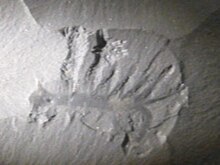Hallucigenia
| Hallucigenia | ||||||||||||
|---|---|---|---|---|---|---|---|---|---|---|---|---|

Hallucigenia from the Central Cambrian Burgess slate |
||||||||||||
| Temporal occurrence | ||||||||||||
| middle Cambrian | ||||||||||||
| 522 to 505 million years | ||||||||||||
| Locations | ||||||||||||
|
||||||||||||
| Systematics | ||||||||||||
|
||||||||||||
| Scientific name | ||||||||||||
| Hallucigenia | ||||||||||||
| Conway Morris , 1977 | ||||||||||||
| species | ||||||||||||
|
Hallucigenia is an extinct genus of animals from the Middle Cambrian .
Two species of these marine animals are known from fossil finds : H. sparsa was found in 1911 by Charles Doolittle Walcott in the slate of the Burgess Formation in Yoho National Park , Canada . The second species, H. fortis , was discovered in 1995 by Hou Xian – Guang and Jan Bergström in the Maotianshan slate of the Chinese province of Yunnan , the place where the so-called Chengjiang fauna was found.
Name and classification
Charles D. Walcott ordered the copies found by him initially falsely as Canadia sparsa along with several others, the counting of the annelids (Annelida) Vielborstern (Polychaeta) and a Priapulid under the generic name Canadia a as polychaete.
The genus name Hallucigenia was introduced by Simon Conway Morris in 1977 when he was re-examining and classifying a number of problematic fossils from Walcott's collection. He chose the name as an allusion to the bizarre exterior of the fossils, which seemed to him to come from a hallucination .
anatomy
In terms of physique, Hallucigenia seems to be close to the animal phylum of the anthropods (onychophores) and, together with some other problematic fossils ( e.g. Aysheaia , Xenusion , Luolishania ), belongs to the group of lobopods . The animal was 0.5 to 3 cm long, had a worm-like body and, according to today's reconstructions , had two rows of tentacle-like extremities on the underside of the body , while the upper side was reinforced with two rows of spiky appendages.
Since only one row of tentacles was initially recognizable in the approx. 30 early fossil finds from Canada and the presumed head region had been poorly preserved, various attempts at reconstruction were made over the course of time, which are now considered incorrect. Conway Morris assumed only one row of tentacles and exchanged the top and bottom as well as the front and rear in his depiction of Hallucigenia . Hallucigenia would have used the spine-like appendages as supports or legs and consumed food with the tentacles.
The reconstruction recognized today comes from Lars Ramsköld, who succeeded for the first time in 1992 in discovering traces of the second row of tentacles and thus identifying them as limbs that were probably used for locomotion. At their ends sat claws, as they are also found in onychophores and tardigrades (Tardigrada) living today .
Chronological order
Mineralized spines and plates (sclerites) of some armored lobopods that have similarities to Hallucigenia ( Microdictyon , Cardiodictyon , Onychodictyon ) are part of the so-called " small shelly fossils ", a group of small, shell-bearing microfossils from the early Cambrian (beginning before approx. 542 Million years ago) has been preserved. Locations such as the Burgess slate and the Maotianshan slate, in which the soft body parts of these animals were also preserved due to favorable conditions, are very rare. It is therefore difficult to determine exactly how long Hallucigenia lived. The Chinese finds date from about 522 million years ago, the Canadian ones are about 505 million years old.
literature
- Simon Conway Morris : A new metazoan from the Cambrian Burgess Shale of British Columbia. In: Palaeontology. Volume 20, 1977, pp. 623-640.
- Derek EG Briggs, Douglas H. Erwin, and Frederick J. Collier: The Fossils of the Burgess Shale. Smithsonian Institute Press, Washington 1994.
- James W. Valentine. On the Origin of Phyla. University of Chicago Press, 2004.
- Martin R. Smith and Jean-Bernard Caron: Hallucigenia's head and the pharyngeal armature of early ecdysozoans. In: Nature . Volume 523, No. 7558, 2015, pp. 75-78, doi: 10.1038 / nature14573 .
Web links
- Past lives: Chronicles of Canadian Paleontology - The Hallucigenia flip Site by the Canadian government agency Natural Resources Canada
- University of California, Berkeley animation site
